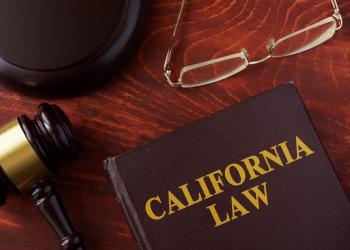
The Hearsay Evidence Rule – Admission and Confessions
From the Classroom
By: Ray Hill, Professor Emeritus, Santa Rosa J.C.
The Hearsay Evidence Rule – Admission and Confessions
This is the sixth in a series of bulletins covering the California Evidence Code and criminal investigations. This next series will cover the Hearsay Evidence Rule as it relates to an officer, deputy, or investigator giving testimony in court (140 E.C.).
We previously covered the Hearsay Evidence Rule and Domestic Violence Investigations (3/24/2022 – LUPC Ref. #CAB00144). This next series of bulletins will breakdown the individual hearsay exceptions.
First, an overview. Hearsay evidence involves evidence of a statement made other than by the witness while testifying that is offered to prove the truth of a matter stated (1200 E.C.). Simply put, this is an "out-of-court" statement by someone else that is offered for proof in court. Example:
A witness attempts to testify to what someone else told her. This testimony is hearsay and will not be admissible unless it falls under a recognized exception.
Hearsay evidence is considered unreliable because there is no opportunity to judge the competency or credibility of the original declarant, there is no guarantee of truthfulness because the original declarant is not under oath or affirmation in court, and there is no opportunity to cross-examine testimony to clarify facts or to impeach testimony. Example:
"In order to encourage witnesses to put forth their best efforts and to expose inaccuracies in perception, recollection, and narration, the Anglo-American tradition evolved three conditions under which witnesses ordinarily will be required to testify: oath, personal presence at trial, and cross-examination”. “The rule against hearsay evidence is designed to ensure compliance with these ideal conditions" (McCormick on Evidence, 7th Edition (2013) pp. 581-582).
However, the Hearsay Rule is known more for it’s recognized exceptions than for the general rule itself. A recognized exception means the hearsay testimony is admissible (1201 E.C.). So, an officer, deputy, or investigator could testify to what someone else told them for proof purposes in court.
For each hearsay exception, there is a legal foundation consisting of the elements making up that exception (like the corpus delicti of a crime). The side offering the hearsay must prove the legal foundation by a preponderance of evidence (51%). The test for trustworthiness embodies a statement in the law that overcomes the general unreliability of hearsay. The credibility or believability of hearsay evidence can still be subject to impeachment and id up to the jury to determine the weight of the testimony.
So let’s examine our first hearsay exception, the second most common one – Admissions and Confessions (1220 E.C.). An admission is a statement by the accused which acknowledges a fact of relevant evidence in a case (motive, opportunity, capacity, threats or expressions of ill will, possession of fruits, instrumentalities, contraband or physical evidence linking the defendant to the crime scene, consciousness of guilt factors, credibility, and method of operation or propensity evidence). A confession is a statement which acknowledges criminal responsibility, i.e. “I did it”. Example:
After a drive-by shooting, defendant's wife acknowledged concealing a gun at her husband's direction. This statement tended to incriminate the declarant as a co-principal in a felony (Peo. v. Wilson (1993) 17 Cal. App. 4th 274).
A statement is an oral or written expression or nonverbal conduct intended as a substitute for oral or written expression (225 E.C.). Examples:
The act of retrieving and handing rock cocaine to an officer was a demonstrative act communicating knowledge of possession (Peo. v. Whitfield (1996) 46 Cal. App. 4th 59); Acts of flashing a gang sign, simulating with fingers the shooting a gun, and making a slashing motion across the throat were non-verbal statements implying a threat of bodily harm (Peo. v. Gonzales (2014) 60 Cal. 4th 533).
The legal foundation for an admission or confession is the statement must be legally obtained. If there is a defense challenge in a “402 Motion” (402(b) E.C.) as to the legality of an inculpatory statement by the accused, the prosecution carries the burden of proof by a preponderance of evidence (51%) to show the statement was legally obtained. A statement taken in violation of the Constitution is inadmissible under the Exclusionary Rule (1204 E.C.).
So you follow the case law rules under Miranda or exceptions to Miranda to prove a statement was legally obtained. Appended at the end of this bulletin is a compendium of case references that have been covered by Legal Update Publishing Company from January 2022 to date.
The test for trustworthiness for an admission or confession is that a person would not make a statement averse to one's penal interest unless that statement was true. Under Declaration Against Penal Interests (1230 E.C.), a statement that exposes the declarant to criminal or civil liability, would subject him or her to risk of hatred, ridicule, or social disgrace in the community can be offered as a hearsay exception.
Another relevant form of admission is an Adoptive or Tacit Admission (1221 E.C.). This occurs when a person is accused of criminal activity but remains silent or fails to deny the accusation. The person "tacitly acknowledges" the truth of the statement because ordinarily one would deny or object to the accusation if it were false. An adoptive admission can be argued as consciousness of guilt (600 E.C.). Defendant can refute an adoptive admission by offering an explanation for his or her conduct, statement, or lack of response. Examples:
A store security investigator confronts an employee about acts of merchandise embezzlement. The employee states, "O.K., what is going to happen to me now " This statement "tacitly admits" the allegation of theft; During a domestic violence investigation a domestic partner tells a deputy, "He slapped and kicked me". The suspect is present, hears this statement, but fails to deny or object to the accusation. The suspect's failure to refute the statement is a "tacit agreement" of its truthfulness.
The District Attorney can’t force the defendant to take the stand and to testify to what he (she) told you (Fifth Amendment – Privilege Against Self-Incrimination). So you are going to tell the trier of fact what the “bad guy (gal) said to you. True hearsay – An out-of-court statement spoken by another coming in as evidence for proof purposes.
Next Up – Spontaneous Statements.
Stay Safe!
RH
Note: That a statement is legally obtained is an essential part of the legal foundation for repeating a defendant’s admission or confession in court. The Legal Update Publishing Company Website is your ongoing resource of case law information covering the Miranda Rule. We will continue to keep you “legally updated”! For example, over the past year we have published the following Case Alerts and Bulletins. Always keep our website in mind if you have a Miranda question!
CASE ALERTS
“When Giving Miranda Rights in English and Spanish, Do It By The Book” – LU Ref. #CAC00092 -2/5/22.
“Talking an In-Custody Suspect Into Changing His Mind Concerning a Prior Invocation” - LU Ref. #CAC00089 (12/22/22).
“Coerced Confession and Offers of Leniency” – LU Ref. #CAC00078 - 8/6/22.
“Miranda as a Prophylactic Rule and the Fifth Amendment” – LU Ref. #CAC00076 – 7/2/22.
“Forfeiture and Coerced Confessions” – LU Ref. #CAC00063 – 3/15/22.
“An In-Custody Suspect Reinitiation of Interrogation After Repeated Invocations” – LU Ref.#CAC00058.
BULLETINS
“Miranda and Civil Liability” – LU Ref. #CAB00184 – 11/2/22.
“Miranda and Fruits of the Poisonous Tree” – LU Ref# CAB00181– 10/19/22.
“You Can’t Dance the Two-Step”– LU Ref. #CAB00179 – 10/4/22.
“Examining Custody Factors for the Purpose of Miranda” – LU Ref. #CAB00174 – 9/1/22.
“Minors, Miranda, and the California Legislature” – LU Ref. #CAB00170 – 8/8/22.
“Handcuffing and Miranda” - LU Ref. #CAB00165 – 7/26/22.
“Voluntary Interviews in the Jail” – LU Ref. #CAB00163 - 7/13/22.
“When the Sixth Amendment Applies to a Voluntary Interview” – LU Ref. #CAB00158 – 6/20/22.
“Questioning a Suspect on an Uncharged Offense” – LU Ref. #CAB00156 – 6/8/22.
“Suspect Reinitiating Questioning After a Miranda Assertion” – LU Ref. #CAB00154 – 6/2/22.
“Reinitiation of Questioning After a Miranda Counsel Assertion” – LU Ref. #CAB00148 – 5/11/22
“Reinitiation of Questioning After a Miranda Silence Assertion” – LU Ref. #CAB00143 – 5/3/22.
“Miranda and the Law – The Fifth Amendment” – LU Ref. #CAB00092 – 2/5/22.







Add new comment